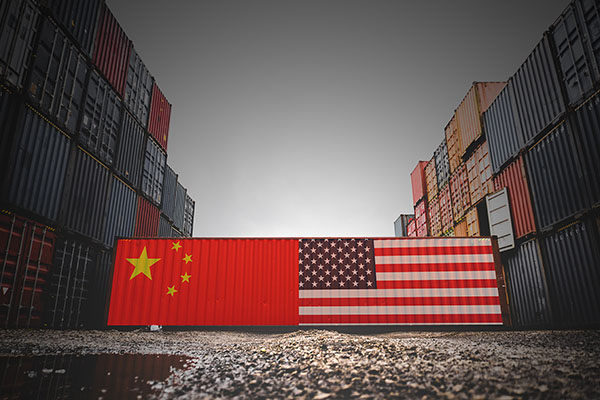U.S.-China back and forth tariff actions are a sign of things to come
As another tariff-related move gets introduced, once again there remains no shortage of speculation and opinions about what it means and what the potential subsequent impact will be on global supply chains.
As another tariff-related move gets introduced, once again there remains no shortage of speculation and opinions about what it means and what the potential subsequent impact will be on global supply chains.
I am talking about the decision made by the White House yesterday to “begin the process of imposing tariffs of 10 percent on an additional $200 billion of Chinese imports,” as per the office of the United States Trade Representative (USTR).
Given all the recent back and forth tariff activity going on between the U.S. and China, it is worth noting that on Friday, July 6 the U.S. began imposing tariffs of 25% on around $34 billion worth of Chinese products, which USTR said were made in “response to unfair Chinese practices.” These tariffs, said USTR will eventually cover up to $50 billion in Chinese imports, with the products targeted by the tariffs comprised of those benefiting from China’s industrial policy and forced technology transfer practices.
As we know, China did not stand pat. It drew its own line in the sand, with $34 billion in tariffs of U.S. exports to China, and warned there could be an additional $16 billion in tariffs coming.
So, with all this tariff activity, the questions are: what happens now? Based on research and anecdotal feedback, it appears that it may be too early to tell.
But that does not mean that there are more than a few opinions kicking around.
Consider this commentary from IHS Markit Asia Pacific Chief Economist Rajiv Biswas, which provides some perspective on the United States’ potential endgame: “The US administration is calculating that because of the large US bilateral merchandise trade deficit with China, which reached $375 billion in 2017, China will run out of US products to impose retaliatory tariffs on long before the US runs out of Chinese products to apply punitive tariffs on. Since total Chinese merchandise imports from the US in 2017 were $130 billion, and US merchandise imports from China were $505 billion, this means that China will not be able to match the proposed US tariffs on an additional $200 billion of Chinese imports to the US.”
Biswas makes some solid points there and he added that the impact of U.S.-implemented tariffs will have a major impact on Chinese exports for various key export sectors like textiles, metal products, auto parts, glass products as well as electrical and electronic equipment.
Chinese exports of electrical and electronic products such as refrigerators, vacuum cleaners, electrical lighting equipment and telephone equipment are among the key Chinese products targeted in the new US list of planned tariffs on an additional USD 200 billion of imports from China, Biswas wrote, adding that the new US list also will hit a large range of Chinese textile products, including cotton and woolen fabrics and yarns. Many Chinese steel, copper, nickel and aluminum products are also included on the list.
But here is where things take a turn, with distinctly different outcomes and takeaways for the U.S. and China, according to Biswas: “For China, the US is its largest export market, accounting for 19% of total Chinese exports. Therefore, if the US escalates its tariff measures to an additional USD 200 billion of products, this would mean that around half of Chinese exports of goods to the US would face significant US punitive tariff measures. China’s export sector will therefore suffer a significant deterioration in export competitiveness to the US compared to other emerging markets’ manufacturing exporters, such as Vietnam, South Korea, Thailand, Bangladesh, Mexico and Brazil.”
Those non-China markets do figure to be playing a larger role, given that there does not appear to be any visible end in sight to this U.S.-China trade war.
That was made clear in a recent interview with Walter Kemmsies, Managing Director, Economist and Chief Strategist for JLL’s U.S. Ports, Airports and Global Infrastructure Group.
Kemmsies explained that in order for global shippers to weather whatever tariff storms may be coming, taking a longer view of trade beyond just the U.S. and China is a good start. That requires looking into setting up production and distribution operations in places like Vietnam and India, as well as parts of Africa, which Kemmsies said are emerging.
“If you are going to operate as a global company, you need to make your decisions that way, too,” he noted. “When you look across certain products, you can see how bad some supply chains are actually managed if they are not. It makes no sense not to truly diversify globally. If you source stuff in one country and sell it in another, you are extremely vulnerable.”
While all the previous tariff-related “noise” is becoming reality, it is telling how strong U.S.-bound imports have been in order to get ahead of the tariff crunch, or what many supply chain stakeholders have characterized as protectionist measures.
That is evident, especially when looking at import numbers at U.S. West Coast ports like the Ports of Los Angeles, Long Beach, and Oakland to name a few. And it makes tons of sense, too. If shippers are able to be able to accommodate an early influx of freight while managing inventory levels and throughput, while avoiding pending tariff-based price hikes, then they made the correct move, right?
Well, on paper it is the right move, it would seem. What happens now, for sure, remains to be seen. Tariffs are, in some ways, becoming the new normal. Pay attention, the supply chain impacts figure to be swift and fluid.













